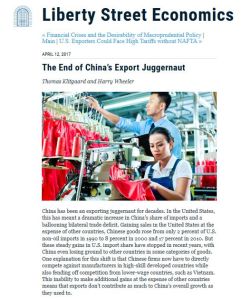Join getAbstract to access the summary!

Join getAbstract to access the summary!
Thomas Klitgaard and Harry Wheeler
The End of China’s Export Juggernaut
Federal Reserve Bank of New York, 2017
What's inside?
China’s undisputed status as an export powerhouse is on the wane.
Recommendation
China’s dominance of US imports began in the 1990s and peaked in 2010. Since then, Chinese shares of apparel, electronics and other manufactured goods coming into the United States have leveled off. According to this succinct report from economists Thomas Klitgaard and Harry Wheeler, the plateau comes as manufacturing heats up in developed countries like Japan and as competition increases for low-cost labor in emerging markets like Vietnam. getAbstract suggests this overview to executives and others interested in the dynamics of China’s economy.
Summary
About the Authors
Thomas Klitgaard is a vice president at the Federal Reserve Bank of New York, where Harry Wheeler is a senior research analyst.

















Comment on this summary